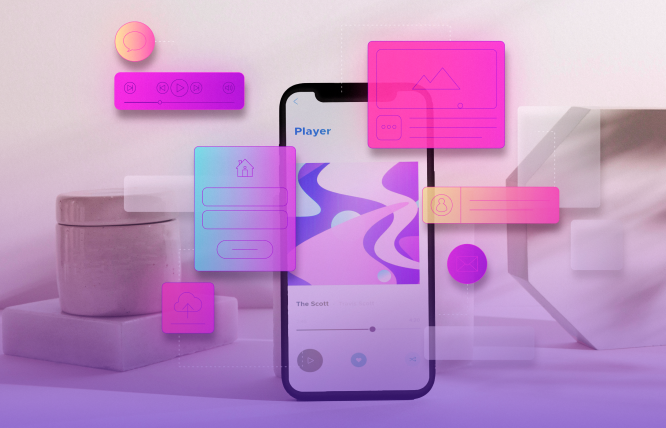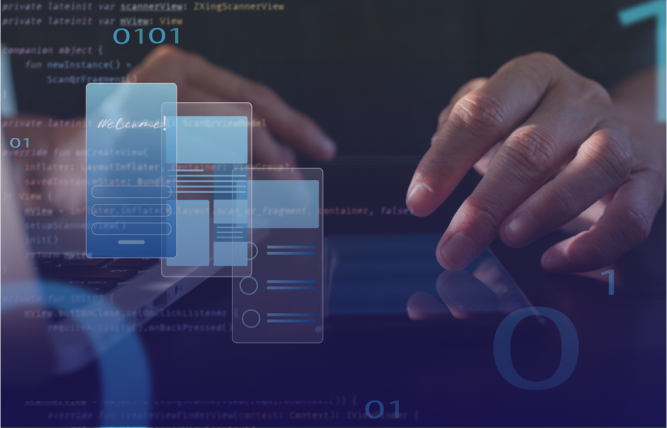Find out how the apps are made from start to finish! This blog provides a step-by-step process of app development, ensuring your app development remain agile.
Before starting an app development project, there are certain guidelines and practices that surround the App Development Life Cycle, which you must follow to keep your app in top shape! Each phase of the application development life cycle unfolds a unique set of challenges and opportunities. The Application Development Life Cycle (ADLC) is your roadmap through this expedition, ensuring your app not only sees the light of day but thrives in the digital realm. Let’s dive into the intricacies of each phase, unravelling the secrets to a successful app creation journey.
What is App Development Life Cycle
The App Development Life Cycle is a systematic process that takes you from the inception of an app idea to its deployment and beyond. It’s the blueprint, the roadmap, and the strategic plan that ensures your app not only sees the light of day but thrives in the competitive digital landscape.
All Phases of the Application Development Life Cycle

The Application Development Life Cycle encompasses planning, design, development, testing, deployment, and maintenance. Each phase contributes uniquely to the creation of a successful and efficient digital application. For a better understanding of each phase, I have broken down the steps into understandable chunks so that you know better what your app development life cycle looks like.
Understanding the Planning Phase
Effective planning serves as a strong foundation for app development. When you clearly plan how to achieve your goal, things become easier, providing you with a brief understanding right from the start of the project.
Scope Definition
In the initial planning phase, clearly define the scope of your app. This involves outlining the features and functionalities it will encompass and setting the boundaries for your project.
Goal Setting and Requirement Analysis
Establish clear goals for your app. What do you aim to achieve? Conduct a thorough requirement analysis to understand the needs of your users, laying a solid foundation for development.
Project Timeline Planning
Craft a realistic timeline for your project. Efficient planning ensures a smooth development process, preventing unnecessary delays and helping you meet your goals within the set timeframe.
Designing a User-Centric App Interface
We create apps for our audience so our goal must be to optimise the app interface for smooth navigation.
Importance of User Experience (UX)
User experience (UX) is the paramount that makes or breaks the app. It focuses on creating an interface that is easy to use, highly functional, and intuitive for users. Prioritising UX enhances overall satisfaction and engagement.
Wireframing and Prototyping
Wireframing and prototyping are essential steps in designing your app. They serve as blueprints, allowing you to sketch the structure and test functionality before finalising the design.
Graphic Design Principles
Graphic design is a language that your app speaks visually. By sticking to principles like balance and simplicity, you ensure a good-looking and super practical interface.
The aim? A user-centric design that looks great and gets information across effortlessly.
Choosing the Right Development Tools and Technologies
Once you have your requirements and wireframes in place, it’s time to pick the tools and technologies for building your app. Let’s get straight to the tools and technologies that you might need to develop an Android, iOS, or cross-platform mobile app.
Overview of Development Tools
It requires detailed knowledge about the tools and stack before starting the app development phase.
For native development, platforms like Xcode (for iOS) and Android Studio (for Android) stand as industry-standard tools. They provide robust integrated development environments (IDEs) with features like debugging, testing, and emulators for a streamlined development process.
Cross-platform developers often turn to Visual Studio Code, a versatile and lightweight code editor, for its flexibility and support for various languages.
Technology Stack Selection
Selecting an appropriate technology stack is akin to building the backbone of your application. Native development often aligns with platform-specific technologies and languages, such as Swift or Objective-C for iOS and Java or Kotlin for Android.
Cross-platform frameworks like React Native or Flutter leverage JavaScript or Dart, offering a single codebase for both platforms. The technology stack extends beyond coding languages and includes considerations for databases, APIs, and server-side technologies. Node.js, Express, and MongoDB are popular choices for their scalability and flexibility.
Considerations of Native or Cross-Platform Development
Native or cross-platform development? Well, it depends on the project’s goals and limitations. Native development provides optimal performance and access to platform-specific features but may require separate development teams and timelines for each platform. Cross-platform frameworks aim to streamline development by allowing code sharing and reducing development time and costs. However, trade-offs may include potential performance differences and reliance on third-party frameworks.
When you’re deciding on the right development tools and technologies, think about
- How complicated is your project?
- What’s your budget for app development?
- What kind of experience do you want users to have?
- Who is your target audience?
Keeping these factors in mind will assist you in selecting the best tools for your app development journey.
The Development Phase Coding Best Practices
In this step, we transform conceptual designs and ideas into functional pieces of code, bringing your ideas to life as a fully operational application.
Clean Code Principles
Writing code is not just about making it work; it’s about making it simple. Clean code follows a clear structure, uses meaningful variable names, and adheres to coding standards.
Agile Development Methodologies
Agile methodologies focus on iterative progress, collaboration, and adaptability. Breaking down the project into small phases allows for regular reassessment and adjustments. This iterative technique makes development more responsive and efficient, reflecting the industry’s dynamics.
Comprehensive Testing Strategies for App Reliability
Test your app before it’s too late, and fix the necessary bugs using automated tools and agile CI/CD processes.
Types of Testing (Unit, Integration, System, User Acceptance)
Ensuring the reliability of your app demands a multifaceted testing approach. Unit testing verifies the functionality of individual components, integration testing ensures seamless collaboration between them, system testing evaluates the overall system integrity, and user acceptance testing guarantees alignment with user expectations. Employing a mix of these testing types establishes a resilient and error-resistant application.
Automated Testing Tools
Automation is a game-changer in testing protocols. Leveraging automated testing tools facilitates the execution of predefined test scripts, expediting the testing process and ensuring consistent outcomes. These tools are indispensable for repetitive tasks, providing swift feedback loops and contributing significantly to overall app reliability.
Continuous Integration and Deployment
Continuous integration and deployment practices are pivotal for app reliability. Automated code integration and deployment enable early detection of issues, maintaining a stable codebase. CI/CD guarantees uniformity from development to production, fostering a more reliable application lifecycle.
Data Encryption and Protection
The security of user data is non-negotiable. Protecting sensitive data and preventing unauthorised access requires strong data encryption. Therefore, encryption and data protection are essential for app security.
Regular Security Audits
The best way to find security flaws and keep ahead of attackers is to do comprehensive evaluations on a frequent basis. Regular audits contribute significantly to sustaining a robust and secure application environment by proactively addressing security concerns.
Smooth Deployment and Maintenance
Deployment and maintenance are also an important part of app development life cycles; let’s see what you need to do:
Deployment Planning
Deployment planning involves transitioning from development to production, considering all the details of your application. A solid plan minimises downtime, reduces potential issues, and ensures a smooth launch.
Bug Tracking and Resolution
After launching, it’s crucial to keep an eye out for bugs. Vigilant bug tracking, using reliable tools, helps identify and document issues quickly. Efficient resolution, often with collaboration between development and operations teams, ensures a stable and trouble-free app environment.
Version Updates and Feature Additions
To keep your app current, a systematic approach to updates and new features is vital. This means looking at user feedback, fixing performance issues, and seamlessly adding new features. A well-structured process ensures that updates are smooth, making the user experience better and keeping the app relevant.
How Many Types of App Development Life Cycle Models Are There?
Waterfall Model
The Waterfall Model represents a linear and sequential approach to software development. Each phase, from conception to deployment, must be completed before moving on to the next. This structured model is suitable for projects with well-defined and stable requirements.
Iterative Model
In the Iterative Model, development cycles are repeated, refining and improving the software with each iteration. This model is beneficial when requirements are subject to change or when continuous feedback is essential for project success.
Incremental Model
The Incremental Model divides software development into smaller, manageable parts known as increments. Each increment is developed and tested separately, allowing for partial implementation and testing throughout the development process.
V-Model (V-Software Development Life Cycle)
The V-Model correlates each stage of the development process with a corresponding testing phase, forming a V-shape. It emphasises the importance of testing at every step, ensuring that software is thoroughly validated before moving to the next phase.
Spiral Model
The Spiral Model incorporates elements of both the waterfall and iterative models. It places a strong emphasis on risk assessment and addresses potential issues early in the development process. The model involves repeating cycles, each iteration refining the software.
Agile Model
The Agile Model is an iterative and flexible approach to software development. It focuses on collaboration, customer feedback, and incremental progress. Popular frameworks within Agile, such as Scrum and Kanban, enable teams to adapt to changing requirements.
RAD Model (Rapid Application Development)
The RAD Model prioritises rapid prototyping and quick feedback from end-users. It is particularly beneficial for projects where speed and user involvement are crucial factors.
DevOps Model
The DevOps Model emphasises collaboration between development and operations teams to improve efficiency, automate processes, and ensure continuous delivery. Ultimately, it aims to connect development and management so that software release goes smoothly.
Big Bang Model
The Big Bang Model is a less structured approach where developers initiate coding without a clear plan. This model is suitable for small projects or experimental development, where requirements may evolve dynamically.
Prototype Model
The Prototype Model involves creating a preliminary model to better understand requirements and gather feedback before full-scale development. It is beneficial when requirements are ambiguous or subject to change.
Different projects may benefit from different App development life cycle models based on their requirements, size, complexity, and other factors. The ADLC model selection depends on project goals and needs.
Which is the best App Development Life Cycle Models (For Android, iOS, Cross-Platform)
| ADLC Model | Use Cases and Considerations | Advantages | Disadvantages | Suitable for |
| Waterfall Model | Well-defined and stable requirements | Simple and easy to understand | Limited flexibility | Small to Medium-sized projects |
| Agile Model (Scrum, Kanban) | Flexibility and adaptability to changing requirements | Frequent releases with continuous feedback | Requires active user involvement | Projects with evolving requirements |
| Incremental Model | Projects with a defined architecture | Early delivery of partial implementations | Complex management of increments | Applications with evolving requirements |
| DevOps Model | Continuous integration and delivery | Improved collaboration between teams | Initial setup and integration challenges | Projects focusing on CI/CD |
Key Takeaways
In simple terms, planning is important in the app development life cycle. You need to figure out the requirements, set goals, and plan accordingly. It’s like making a map for your app journey. Also, make sure the app is simple and intuitive for users.
Choosing the right tools and methods to build an app is a crucial decision and it depends on whether you want the app to work on a single platform or multiple platforms. Once you have decided on a development approach, the next step is to write clean and efficient code. After writing the code, it’s important to test the app to ensure all elements are functioning properly.
Maintaining the app’s smooth performance and fixing any bugs that occur is also essential. In the end, the goal is to integrate all the components in a smart way to create a useful and engaging app that people value to use.
Frequently Asked Questions
Have questions or feedback?
Get in touch with us and we‘l get back to you and help as soon as we can!




